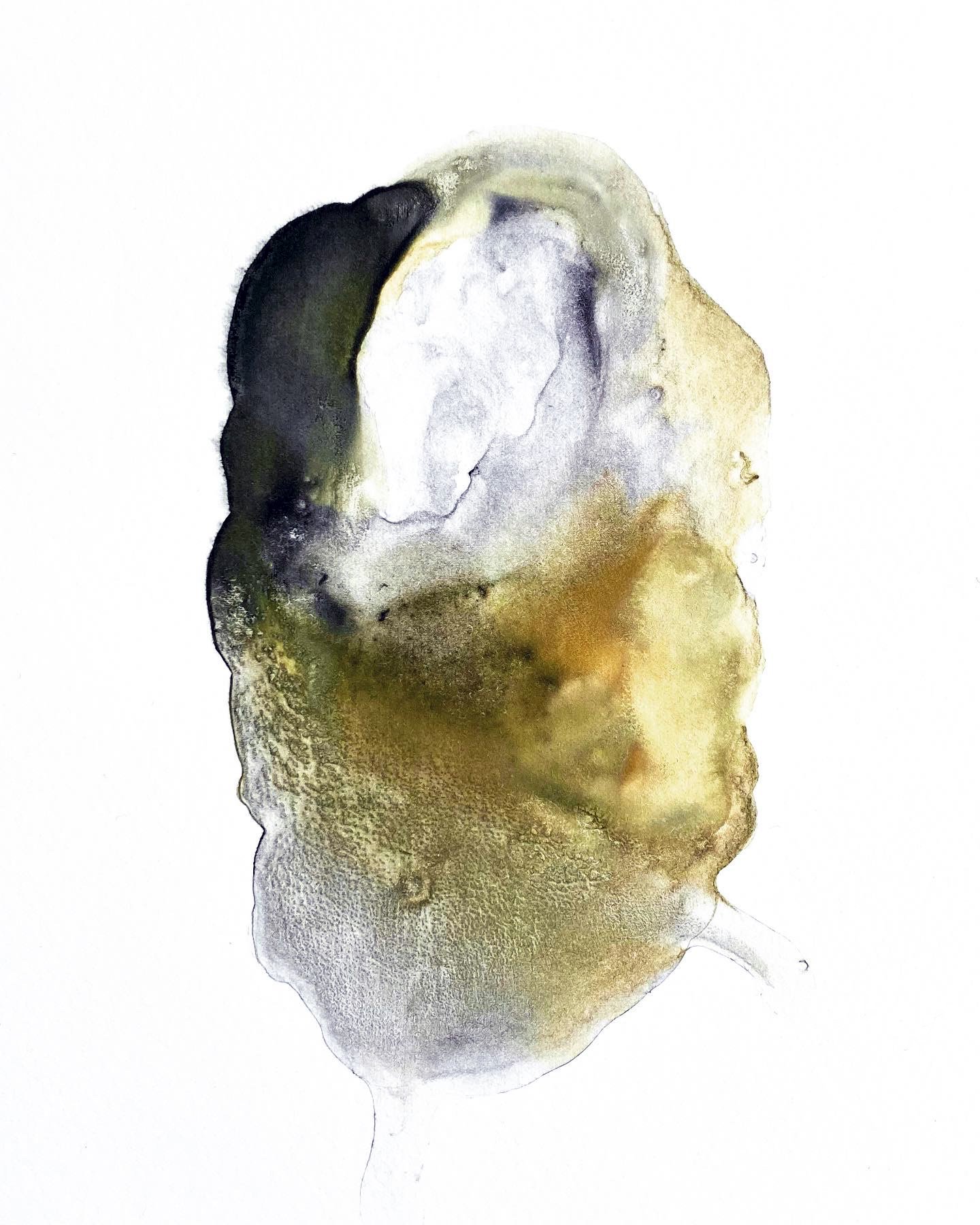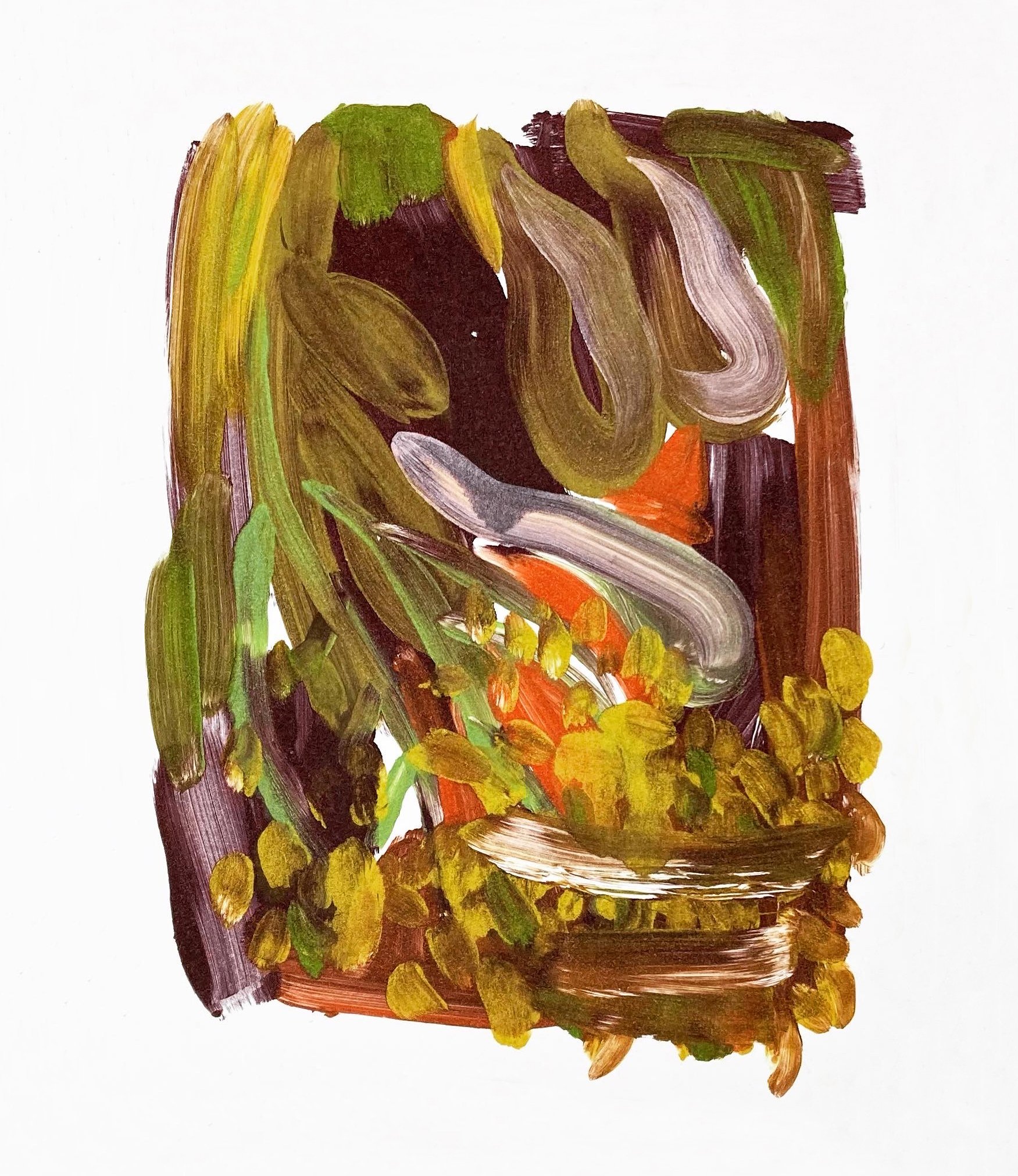printmaking
Lithography and etching have been my favoured printmaking mediums, the process and aesthetic are equally seductive, although they involve working with known carcinogenic chemicals. For several years I have been coming to terms with how these materials affect our environment, particularly after a breast cancer diagnosis, and how this is shaping my printmaking practice.
My preference now is to use water-based and water-soluble inks that do not contain hazardous pigments or binders, and clean up with soap and water. Monoprints and monotypes, drypoint intaglio, linocut, woodblock and woodcut relief techniques work well with non-toxic inks that do not contain plastics. My digital prints are made with soy-based inks. These methods also use sustainable materials that are bio-degradable or compostable. They are kind to Country.
A Song Made Visible 2009. Etching on silk, solid silver castings, human hair, unique state. Silver castings are made with the lost wax process, from twigs and leaves picked up off the ground in my local neighbourhood. The scale of these objects, when created in silver, allude to jewellery and the idea of inheritance, being passed down the generations. These castings of natural detritus around my urban home refer to inheriting environment as the most precious thing we can pass on to the next generation.
A Song Made Visible I 2009. Etching on silk, solid silver casting, human hair, unique state
A Song Made Visible I 2009. Etching on cotton, solid silver castings, human hair, unique state
Barossa Range 2009. Etching on cotton, solid silver castings, human hair, unique state
Oak, Abbotsford Convent 2009. Cotton embroidery on silk, digital print on hahnemuhle
Circle 2010. Screen print on silk, unique state
Untitled 2006. Stone lithograph, unique state
The Seven Seas 2011. Stone lithograph with powdered gold, edition 1/4
Losing the thread (self-portrait) 2011. Stone lithograph, edition 1/10
One day, all this will be yours (self-portrait) 2011. Stone lithograph, edition 1/10
Isabel wears the pants 2011. Stone lithograph with powdered gold, edition 1/10
Skirting the Issue 2005. Stone lithograph, oil-based tusche wash, edition 1/8
Self-portrait 2006. Carborundum collagraph, unique state
Untitled 2006. Etching, sugarlift, aquatint, edition 1/10
Untitled 2022. Monotype
Untitled 2022. Monotype
Untitled 2022. Monotype
Baldessin garden 2022. Monotype
Baldessin garden 2022. Monotype
Untitled 2022. Monotype
Circlework 2022. Monotype
Circlework 2022. Monotype
You are Her 2019. Turmeric and silk
You are Her addresses the history of feminist politics through the symbolism of colour and the form of the banner as protest. Referring to the American Equal Rights Association founded in 1866 that adopted yellow as their signatory colour, used by women at their rallies and protests, this reinforced the decision to not only use the colour yellow but to also use the edges of each work to create more expansive, centrifugal compositions.
Created as an homage to botanist and photographer Anna Atkins, You are Her employs the cyanotype process Atkins used to make photogenic drawings - the first person to record specimens of algae as white negative images on a blue background, later produced as a book of photographic illustrations.
Utilising the cyanotype, I have adapted the process dyeing the fabric yellow with turmeric - ‘the fade’ symbolising absence on the one hand, at the same time, highlighting the absence of documentation of female artistic participation in the professional sphere.
Looking-glass Houses 2019. This self-portrait series builds upon the theme of female representation within and outside of the institutional setting through a literal and metaphorical lens. Reviewing women artists and the power structures that exist within cultural institutions, I observed how women seem only to exist as ‘accepted’ insiders as opposed to being valued and significant contributors within the arts and culture sector.
Created as an homage to American street photographer Vivian Maier, whose work highlighted female ‘presence’ by way of including her reflection i store windows, i created my first work in this series photographing my silhouette by chance at the Auckland Art gallery Toi o Tamaki - a serendipitous discovery that became a purposeful endeavour.
Using my iPhone, as an egalitarian marker of time and the communal making and ‘sharing’ of images, these prints on fabric also explore the sheen and fluidity of the material as a way of recreating reflections on glass, while considering the physical scale of each work in relation to and on the body.
Looking-glass Houses installation, solo exhibition. Post Office Gallery, Ballarat 2019
Self-portrait: Redhead (Yayoi Kusama Museum elevator) 2017. Digital print on silk
Self-portrait (Yayoi Kusama Museum) 2017. Digital print on silk
Self-portrait (Heide Museum of Modern Art III) 2017. Digital print on silk
Self-portrait (Heide Museum of Modern Art II) 2017. Digital print on silk
Self-portrait (Tarrawarra Museum of Art) 2017. Digital print on silk
Self-portrait (National Gallery of Victoria International) 2019. Digital print on silk
Self-portrait (Ian Potter Centre, National Gallery of Victoria Australia) 2018. Digital print on silk
Self-portrait (Ian Potter Museum of Art, the University of Melbourne) 2018. Digital print on silk
Self-portrait (Art Gallery of Ballarat) 2019. Digital print on silk
Self-portrait (Auckland Art Gallery Toi o Tamaki) 2017. Digital print on silk
#onthetrain 2017-2019. iPhone photographs. Digital print on linen (detail)
Observing graffiti from the train window, along the railway line between Melbourne and Ballarat, was a regular reminder that street art is primarily a male-dominated subculture.
As a consequence, I created this work as an homage to San Francisco-based street artist Margaret Kilgallen who painted on freight trains in remote railway sidings working under street art aliases, Matokie Slaughter and Meta.
As a way of acknowledging Kilgallen and women in general for whom making art and occupying dark, industrial, urban or rural places is a serious risk and challenge, I utilised Instagram as a way of sharing a diaristic body of work that documents what I saw from the train window. The train became my ‘studio’, a safe place to work that took me through all those spaces day and night.
The work also emphasises that by publicly sharing images as they are being made, as a form of ‘absent’ self-portraiture, censorship and freedom of artistic expression are brought into question in the interest of public security and moderation.
#onthetrain 2017-2019. iPhone photographs, entomology pins, digital print on linen
#onthetrain 2017-2019. iPhone photographs, entomology pins, digital print on linen
Bedell Nonfictionow Conference. Untitled hairbrushing performative piece during the swapshop laboratory opening, in collaboration with Lyndal Walker. Photography, human hair, peroxide 2012
Hair was gathered from the hairbrushes of all participants to create one lock of hair. Each strand of hair contains our individual dna, revealing truths about our biological selves and our ancestors.
Swapshop Laboratory research group: Lucinda Strahan (curator), Concettina Inserra, Georgia Janetzki, Lyndal Walker and Jessica Wilkinson. Our exhibition catalogue in the form of swap cards, held together with hair elastic bands 2012
Jareseben 2020. Film photography, digital print
Jareseben 2020. Film photography, digital print
Jarasaben 2020. Film photography, digital print
The presence of trees 2020. Film photography, digital print













































